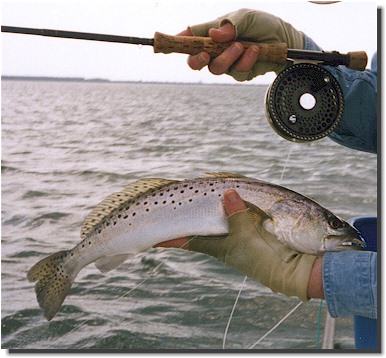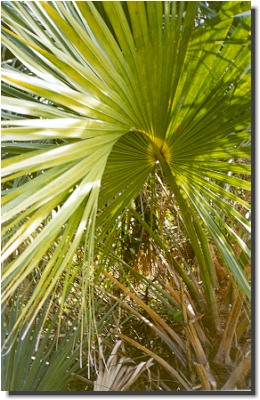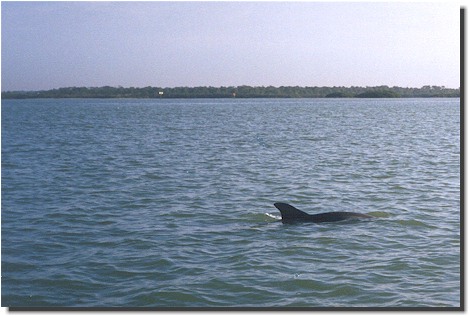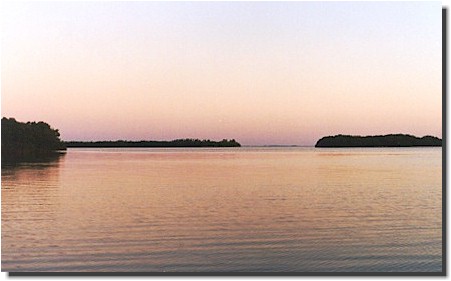FLORIDA BACKCOUNTRY JOURNAL

"Spotted Sea Trout from the grass flats" Photo: Capt. Ian Devlin
Florida Backcountry Journal Photo Page
Journal entries and photographs by Chris Windram
Home | Saltwater Flies | Fly Tying Materials | Saltwater Fly Fishing Accessories
Ordering Instructions, Shipping rates, Your Satisfaction Guaranteed | Site Map

"Spotted Sea Trout from the grass flats" Photo: Capt. Ian Devlin
Journal entries and photographs by Chris Windram
Sunday, April 1, 2001.
2:15 PM. My long-awaited flight from Hartford, Connecticut to Fort Meyers, Florida is all smooth sailing. Capt. Ian
Devlin picks me up at the Ft. Meyers airport under sunny skies. Air temperature at Ft. Meyers: 78 degrees.
Air temperature back home in Massachusetts: still dismally cold. I'm leaning out of the open window
of the truck on the drive north towards Punta Gorda. A warm breeze, palm trees, and the prospect of
fly fishing in the Florida backcountry have begun to heal my winter woes already.

6:15 PM. Unpacked and ready to fish. Ian drives us to a local golf course where we cast flies for baby tarpon in the water hazards. Tarpon up to twenty pounds are rolling in the ponds as the golfers are heading for the 18th hole. We cast faithfully, but utterly fail to interest even a single tarpon.
Monday, April 2.
6:00 AM. Capt. Ian Devlin is off to "work", poling happy tourists from Boca Grande around
the Florida Backcountry for snook, tarpon, ladyfish, redfish, and seatrout. Ian has trips
booked every day this week, but he has offered me the use of a little tin boat which is docked on the
creek outside of the house, a generous offer which I immediately accept.
6:30 AM. I'm in the tin boat, headed down a small saltwater creek and out into the waters of Lemon Bay. Mullet skip ahead of the boat as I make my way down the creek. The sun is just peeking over the horizon as I find my way out into the bay. I spend the morning exploring, watching porpoises catching fish, drifting over the grass flats, even motoring through Stump Pass out to the Gulf of Mexico.
2:30 PM. I'm back at the house, having lunch. Ian returns from a successful morning trip to pick me up. Half an hour later we're in the flats boat and headed back out to the flats and mangrove islands of Charlotte Harbor.
3:30 PM. Ian baits up a spinning rod with a live shrimp and starts casting to holes in the grass flats, trying to locate some seatrout. Two casts are all it takes, as Ian hooks up with a nice trout. He gets a ladyfish, then a sailcat, and then we both rig up fly rods for the afternoon bite. Sea trout and ladyfish keep us busy for the rest of the afternoon, then we go looking for snook lying among the mangrove roots. We spot some decent fish along the margins of the mangrove islands, but my casting goes all to pieces. I blow a good shot at an especially large fish before we decide that the snook aren't really all that hungry. We are treated to the sight of an osprey and an eagle catching their fish dinners before dusk finds us loading the boat back onto the trailer.
Tuesday, April 3.
5:30 AM. I'm in the tin boat early, since Ian has to work again. I spend a productive morning
in Lemon Bay now that I know a bit more about finding the fish. I find sea trout and ladyfish
eager to take a fly this morning, and I release about three dozen fish during the
course of the day. I spend some time in shallower water searching for redfish, about which I have read much, but
experienced little. No redfish come to my fly, but I return to the house in the late afternoon
feeling very pleased about the sea trout and ladyfish.
6:30 PM. Ian and I are back at the golf course ponds. Ian has said that these ponds can really turn on at times, but I'm doubtful until Ian jumps a tarpon of around twelve pounds. This wakes me up, and I start fishing harder, but that's the only fish we see this evening.
Wednesday, April 4.
5:30 AM. Back in the tin boat, the sea trout and ladyfish provide steady action once again,
and I land a few other small unidentified fish on the fly rod.
Porpoises are everywhere today, chasing sea trout, tossing them into the air when they catch
them. I recognize one porpoise from the day before by its oddly shaped dorsal fin
(probably a healed scar from an outboard propeller). Ian has two trips today, so
I spend the entire day in the little tin boat; driving out to the Gulf again and exploring
the backwaters of Lemon Bay. I feel a deep relaxation settle into my soul, brought on by the
sun and sea, and the hours spent drifting with the tide in the little tin boat.
Dusk finds me driving the boat far up Ian's creek to find a secret pond where
small snook and tarpon are popping and rolling. I watch the fish without casting, then
I float back down the creek with the outgoing tide. Back at the house,
I fall asleep dreaming about the redfish that I had hoped to catch on this trip.
Thursday, April 5.
5:30 AM. Ian leaves for work, and I launch the tin boat once again. The weather is warm this
morning, and a bit windy with a threat of rain forecast for the afternoon. The trout and
ladyfish seem sluggish and reluctant to bite this morning, and I only land a half-dozen
or so in the usual spots before heading off to try some new waters. At the edge of a
nice deep hole in the grass flats, a blind cast to the dropoff produces a solid strike.
This fish pulls much harder than the trout, and a minute or two later I'm holding my very first
redfish in trembling hands.

10:00 AM. I'm now drifting across a grass flat on the western edge of the bay, and redfish are everywhere! I get some good casts, hook a very nice redfish of ten pounds or more, but the hook pulls free before I can land the fish. I spot fewer fish on the next drift, but one very agressive catfish surprises me by eating the fly. On the third drift through the flat, the reds seem to have disappeared. I spend the rest of the day searching for more redfish, but the bite is over. Back at the house that evening, Ian is excited to hear about the redfish action. Ian promises to drop me off on an island on Friday where I can wade hard sand flats while sightcasting to tailing redfish. Needless to say, I can't wait.
7:30 PM. Ian drives us to the golf course ponds for the evening rise of baby tarpon. Along the way, I spot a rare sight; two sandhill cranes stalking in a roadside field. Later at the greens we get soaked by a brief but heavy downpour of rain; the first rain we've had all week. The weather seems to have got the fish going, though, because we see a lot of activity. I play and release several small snook before I finally land my very first tarpon. This monster is easily ten inches long. We snap a quick photo of the little guy, then release him to grow up. Needless to say, in spite of his puny size, I'm quite pleased with my little tarpon.
Friday, April 6.
7:00 AM. Ian launches the boat and drives out into the backcountry, dropping me off on an island in
Charlotte Harbor. He leaves me there with some lunch and water, and heads off to pick up his
charter at the dock. I say a little prayer that Ian will be able to find me again, then pick up my
flyrod and begin to wade the flats.
9:00 AM. After wading the flats without incident for an hour and a half, the first redfish appears. Sight casting to these fish tailing and cruising over the flats is a real treat. I land four, and lose one very big red after a brief wrestling match. Just after losing the big fish, I'm startled by three long dark fish racing by in formation at the edge of the flat. I cast to the fish, which are probably cobia, but there are no takers. I head back to shore for a bit of lunch.
2:45 PM. Back in the water, I've waded down the flats to a little creek that comes out of the mangroves. The creek channel is too deep to wade, and anyway I can see fish activity on my side. Baitfish spraying out of the water is a familiar site to a New England saltwater fly rodder, and I don't hesitate to get a cast off quickly. I'm rewarded by a sharp pull, and a snook of twenty inches or so launches himself skyward, much to my pleasure. I release the snook, and ten minutes later I catch another fish of the same size which is harassing the same school of small baitfish. Ian arrives a few minutes later, and despite the great fishing, I'm glad to know that I won't be spending the night on the island. Who knows what furtive creatures roam the mangrove islands of the backcountry in the dark of night?
4:00 PM. Ian treats me to a tour of Charlotte Harbor. We pay a visit to Captiva Pass where we watch a boat dunking chunks jump a tarpon of a hundred pounds or more. We cast flies for tarpon for an hour without result, then head for the pass at Boca Grande. In the Gulf outside of Boca Grande pass, we find a small fleet of shrimp boats, but the boats are at anchor and not fishing, so we leave them and drive northwards toward home, stopping in the backcountry to cast for snook here and there. The evening sun dips redly into the Gulf of Mexico as Ian cranks the boat onto the trailer.
Saturday, April 7.
6:30 AM. On my last day in Florida, Ian's charter cancels. With the day to ourselves,
we hitch up the flats boat and
head off to the Myakka River, where we see gar, snook, and a few largemouth bass.
Not too many fish are in a biting mood, however, and we get skunked in the river.
Later, at the mouth of the river, we will see jack crevalle and larger snook, but still fail to
connect. Mid-afternoon finds us heading home after an afternoon spent exploring mangrove
islands, channels, and flats, and I remark to Ian that this is the first day that I haven't
landed a single fish. Oddly enough, I'm not disappointed in the least.

6:15 PM. My bags and tackle are packed away, ready for the dawn drive to the airport. I'm sitting on the dock over the little creek at Ian's house, reflecting on a wonderful trip while watching the mullet and small snook jumping around. Ian's off on business for the evening, so I drop the little tin boat in the water for a farewell cruise up the creek. Almost as an afterthought, I grab a light spinning rod and a few topwater plugs from the porch.
7:05 PM. I'm back at the secret pond at the upper end of the creek. I tie the boat up to an old stump, then hop out to take a couple of casts on foot. As I step out onto the bank, I see a jack crevalle of ten pounds or so leaving the little inlet to the pond! My cast is fruitless, however, as I've already spooked the fish. A dozen casts later, a little wake approaches my black Yo-Zuri Walkin' Dog. With no further warning, the plug disappears in a tremendous explosion. The biggest snook I've ever seen goes airborne in a fantastic display of aerial snookness. The big fish jumps again and again. Then the tiny spinning reel starts screaming as the snook gets wise and heads for the tangle of the mangroves. After more than a few tense moments trying to pry the fish out of the mangrove roots using tackle better suited to largemouth bass fishing, I slide the snook up at my feet. My conservative estimate of the weight of this absolutely beautiful predator is about sixteen pounds. As I release the precious fish, his broad tail throws a bucketful of water, and soaks me.
7:20 PM. Three casts after releasing the big snook, another fish grabs the topwater plug. This time it's Mr. Jack Crevalle, another new species for me. This fish doesn't jump, but bores its way out into the center of the pond. Fortunately for me, the jack is fairly small, and I land it without further incident.
7:35 PM. Another heart-stopping explosion, and I set the hook. This time a ten pound tarpon heads for the sky, while I duck to avoid a full facial confrontation with a flying Yo-Zuri Walkin' Dog. By this time, I'm shaking in my shoes. Another cast, and another tarpon strikes. I strike back, and another silver king throws the plug in my face. My hands are trembling badly as I re-tie the knot in the fifty pound shock tippet, which has suffered much abuse from the snook and tarpon. On my third cast, something big blasts the plug into oblivion. A tarpon of twenty pounds or more goes airborne, and this time I'm ready to dodge the deadly Yo-Zuri missile which has been fired in my general direction. By the time I get the line untangled from the palmettos, the action has subsided.
7:55 PM. The warm Florida evening surrounds me as I drift homeward down the creek. I won't soon forget my first trip to the backcountry. Flyrodding for backcountry gamefish against a backdrop of warm skies, wilderness, and wildlife has driven the ice and snow from this winter-weary New Englander's heart. I have no doubt that I will return someday to watch the porpoises roll in the bay, and ride the gentle tide once more across the flats at dawn.
Go back the Photo Page for this article | Wade back to the Home Page